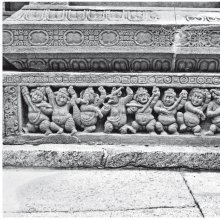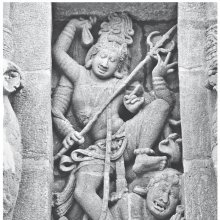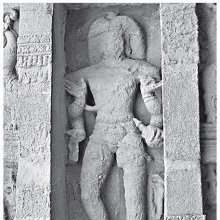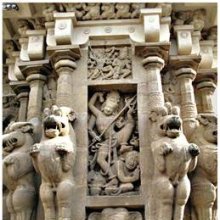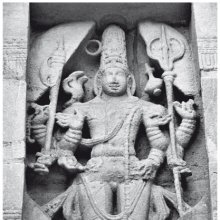Sanctuary: 1 definition
Introduction:
Sanctuary means something in Hinduism, Sanskrit. If you want to know the exact meaning, history, etymology or English translation of this term then check out the descriptions on this page. Add your comment or reference to a book if you want to contribute to this summary article.
Images (photo gallery)
(+60 more images available)
In Hinduism
Vastushastra (architecture)
Source: Shodhganga: Elements of Art and Architecture in the Trtiyakhanda of the Visnudharmottarapurana (vastu)The Sanctuary (of a Temple) is denoted by the Sanskrit term Garbhagṛha and refers to the “central hall” part of the Hindu Temple, according to the Viṣṇudharmottarapurāṇa, an ancient Sanskrit text which (being encyclopedic in nature) deals with a variety of cultural topics such as arts, architecture, music, grammar and astronomy.—Garbhagṛha means the central hall i.e., the Sanctuary in the middle, where the statue of the deity is placed. The term itself refers to a place which is not seen from outside like a womb in a female body. The garbhagṛha is basically a small room inside the main temple which is mostly square in size, plane or rectangular as well as many-sided or circular in rare cases. The Viṣṇudharmottarapurāṇa recommends a separated room inside the main temple which can be considered as the Sanctuary (garbhagṛha) or Womb chamber of the temple.

Vastushastra (वास्तुशास्त्र, vāstuśāstra) refers to the ancient Indian science (shastra) of architecture (vastu), dealing with topics such architecture, sculpture, town-building, fort building and various other constructions. Vastu also deals with the philosophy of the architectural relation with the cosmic universe.
See also (Relevant definitions)
Full-text (+153): Garbhagriha, Garbhagara, Garbhabhavana, Garbhara, Mandira, Ayatana, Kukkutamandapa, Sahacaityavat, Magadha, Mekala, Uddiyana, Devalaya, Kalinga, Devikotta, Radha, Prayaga, Simhala, Avarodhana, Suvarnabindu, Garbhageha.
Relevant text
Search found 86 books and stories containing Sanctuary; (plurals include: Sanctuaries). You can also click to the full overview containing English textual excerpts. Below are direct links for the most relevant articles:
The Garuda Purana (by Manmatha Nath Dutt)
Chapter LXXXI - A brief description of holy pools and sanctuaries < [Agastya Samhita]
Chapter LXXXIII - Description of different rites < [Agastya Samhita]
Chapter LXXXVI - Merit of performing Sraddhas at Preta Sila < [Agastya Samhita]
Vastu-shastra (5): Temple Architecture (by D. N. Shukla)
Layanas—Early Mauryan Specimens < [Chapter 12 - History of Hindu Temples (Prāsādas and Vimānas)]
Temples of Madura, the final phase (from 1600 A.D.) < [Chapter 12 - History of Hindu Temples (Prāsādas and Vimānas)]
Bhaumika Vimānas (Temples of South India, Decan and Greater India) < [Chapter 12 - History of Hindu Temples (Prāsādas and Vimānas)]
Diaspora of Bhuta (Daiva) worshipping cult—India and Indonesia (by Shilpa V. Sonawane)
Part 7-8 - Jumadi (or Dhumavati) < [Chapter 1 - Introduction]
Part 1.7 - Gods and Spirits < [Chapter 4 - Inter-Disciplinary Analysis]
Part 8 - Balinese Religion < [Chapter 4 - Inter-Disciplinary Analysis]
International Affairs: A Survey < [July 1970]
A Short Introduction to A. R. Ammons < [April – June, 2000]
I See Your Face < [March 1946]
The Way of the White Clouds (by Anāgarika Lāma Govinda)
Chapter 50 - The Discovery of the Secret Path and the Temple of the Great Maṇḍala < [Part 4 - Return to Western Tibet]
Chapter 37 - The State Oracle of Nāchung < [Part 3 - Death and Rebirth]
Chapter 27 - U Khanti, the Seer of Mandalay Hill < [Part 3 - Death and Rebirth]
Manasara (English translation) (by Prasanna Kumar Acharya)
Related products
